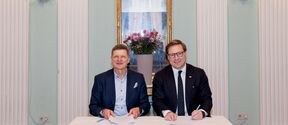Ambiguous problems require new types of leadership

‘I'm in the wrong place,’ thought researcher Satu Rekonen as she began her cross-disciplinary product development project course, which is part of the Master's Programme in International Design Business Management. She was the only business student on the team and had no experience with prototyping. However, as her studies progressed, she realised that a different background was actually a strength. She was able to focus on the team's internal communication and pose questions that led to fruitful discussions.”

Later, this first-hand experience ignited Satu Rekonen’s interest in multidisciplinary teams and their leadership. In her doctoral dissertation, she examined how professionals and project managers unfamiliar with creative problem-solving approached ambiguous problems. An example of an ambiguous problem might be how to get people to use electric cars or how to make an organisation the world’s best place to work.
According to Satu Rekonen, working life projects will increasingly be about solving creative and complex problems.
‘Students have historically familiarised themselves with their chosen field by doing routine tasks, but in the future, these will be handled by automation. As a consequence, newcomers will face complex problems at the beginning of their careers.’
Uncertainty is difficult to tolerate
According to Satu Rekonen's research, those who are inexperienced with creative problem solving tend to jump quickly to a particular solution instead of exploring alternative solutions. According to Rekonen, it should be accepted in project work that there may be more than one right solution for projects. A good outcome requires experimentation, discussion, learning, openness and building trust.
Below, Satu Rekonen outlines how a project manager can create the conditions that support a team in solving complex problems.
- Know your team's capabilities.
Multidisciplinary problems are often solved in multidisciplinary teams. In order to make the most of the capabilities of the entire team, everyone must be able and willing to bring forward their own expertise. At the beginning of the project, it is helpful to create structures that support the visibility of the team's expertise. - Create a feedback culture within your team.
Misunderstandings between people often originate from small isolated situations. When these situations are not diffused by talking, team’s activities begin to build on assumptions that are often unfavourable. When your team has established feedback methods, there is no room for such assumptions. - Learn to tolerate uncertainty and also support your team members in tolerating uncertainty.
When creating something that does not yet exist, uncertainty is present in its various forms. Uncertainties about the final solution and the roles of the team members should be discussed and reviewed on a regular basis. - Be curious about other people’s views.
There is no single right solution to ambiguous problems. Understanding other points of view is important. You can also learn from other team members. Different perspectives help to build a common understanding for the team. - Lead by example to support constructive and open interaction.
Practices for constructive and open interaction are created in the early stages of a project. Leading by example has a great effect. Constructive and open interaction consists of small things like eye contact, listening to one another and asking open questions.
Read more news

The semiconductor sector jobs open in research groups
Semi-Summer 2026 programme will provide an opportunity to gain the skills needed in a growing and international semiconductor sector.
New cooperation agreement between the City of Helsinki and Aalto University to strengthen a sustainable, vibrant and knowledgeable city
The main themes of the cooperation are vitality, innovations and entrepreneurship, as well as research cooperation and knowledgeable labour, drawing heavily on the research and education expertise of the university.
Aalto Inventors innovation training coming for hydrogen, quantum and microelectronics researchers this spring
Connect with industry and academic thought-leaders and gain widely applicable skills in communication, intellectual property, and business.






